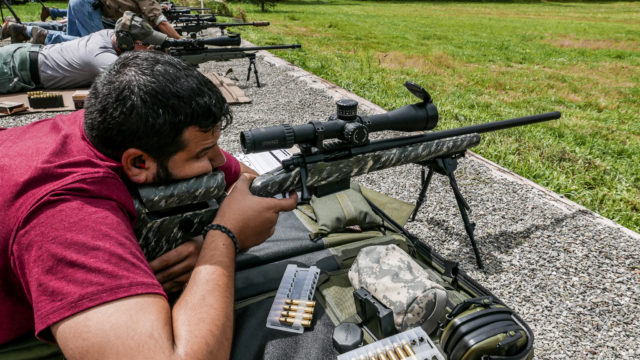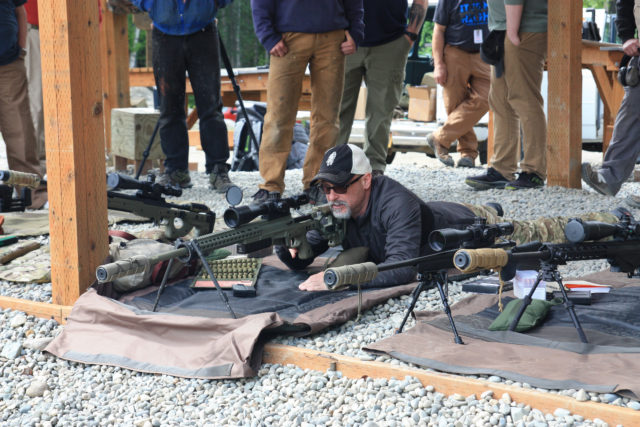[g1_dropcap]W[/g1_dropcap]e all know, muscling the rifle is a bad thing. When recounting the Fundamentals of Marksmanship, NPA is the very first one. We describe NPA as; body pointed to the rifle, rifle pointed at the target. In other words, we are relaxed, lined up straight behind the rifle free of muscular tension to hold the reticle on the target.
This all changes when we hold for the wind. Thanks to video, we can see just how much a wind hold can result in muscling the rifle to line up the shot. Doesn’t seem like much until you look at it from the other side. Remember a little goes a long way when you are shooting extended distances.
Shooting my 20” 308 with a muzzle velocity of 2575fps out to 1125 yards, in even a modest wind of 7MPH I need a 2 Mil wind hold. In the video, I show you just how far that hold moves the rifle. It’s more than you realize. Just imagine extending that distance to beyond a mile with a magnum. The muscling used is significant at these distances.

So when do we hold, and when do we dial. That is the next logical question. If holding for the wind do we have the time and opportunity to adjust our NPA?
While everyone is different, I have a few suggestions to consider:
Hold for the entire wind when it’s less than 1.5 Mils or 6 MOA
Hold for the wind between 200 and 800 yards.
Dial back to the center when the hold goes beyond 1.5 Mils
Distance should give you time and opportunity, use that time to line up the shot including the wind hold properly by adjusting your natural point of aim.
Now, this may not work for every situation; you have to be dynamic when considering these factors. Don’t let the question confuse or slow you down. But create a series of small rules of thumb for yourself. Have a plan so when faced with these situations you can solve the problem without compromising your fundamentals.
As I have advocated in other lessons, it’s important to have a plan when attacking the wind. I DOPE the wind using a Kestrel for about 2 minutes so that I can establish the Highs, Lows and Average wind speed. I then give a value to these speed in mils based on the system I am shooting. This allows me to attach an actual number to the wind call.
Much like people do with multiple targets at multiple distances, you want to look the wind as three different values. These three wind calls will have three separate holds. Knowing those holds will not only speed up your shot process, but it will also help you learn to dope the wind quicker. You not only visualize what is happening downrange, but you have a value for those visualizations. If you dope the wind at 6 MPH and your hold is 1.2 Mils, and the shot needs 1.5 Mils to hit the target, you just learned something about your call.
 In the prone, your NPA is not as critical as it can be with something like Sling Shooting, or even Alternate Positions. NPA is much more critical when you are off your belly. Because the rifle is held off the ground, it will be affected by your natural point of aim alignment. Poor Natural Point of Aim doesn’t necessarily change the group size, but will instead move the group off center. If you muscle the rifle, when your body experiences recoil, it will relax and move the rifle back to where it is naturally aligned.
In the prone, your NPA is not as critical as it can be with something like Sling Shooting, or even Alternate Positions. NPA is much more critical when you are off your belly. Because the rifle is held off the ground, it will be affected by your natural point of aim alignment. Poor Natural Point of Aim doesn’t necessarily change the group size, but will instead move the group off center. If you muscle the rifle, when your body experiences recoil, it will relax and move the rifle back to where it is naturally aligned.
Think about this action with a heavier magnum. Much more recoil, much louder bang, and a bigger chance the body will reaction in a negative way. You see many more shooters flinch with a magnum vs a 223. If you are using a magnum, shooting much farther, these little details are critical. Take the time to line the shot including your wind call.
It could be one of the reasons your wind calls do not line up. Because your NPA forces you to increase the call due to muscling the rifle. Try dialing back to the center, doping the average and holding the gusts or lulls in the wind. These smaller adjustments will prevent the urge to muscle the rifle further than necessary.
Line up your NPA based on the wind hold and not just on the center of the crosshairs. Many will line up first and then move as part of their internal process.
At the end of the day, you want to believe the bullet. See the results of your shot, and adjust based off what you see in the reticle. Natural Point of Aim can also help keep you on target. When the shot is fired, the body will relax, and if you are muscling the rifle, it will steer you off course. One of the reasons new shooter cannot spot their shots downrange.
When hearing of people having difficulties with recoil management you have to wonder if this is a result of a compromised NPA.
These are small errors that can add up causing you to miss the target. Especially at extended long distances. If you are compromising a fundamental of marksmanship, you may be inadvertently causing an accuracy problem.
See what your sight picture looks like after holding the wind, and look at your sight picture after dialing closer to the center? If you see a difference, NPA might be the problem.
Test your Natural Point of Aim; distance is supposed to afford you time and opportunity, take advantage of that opportunity.

